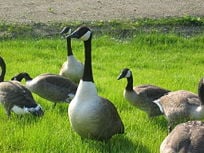Goose
| Geese | ||||||||||||
|---|---|---|---|---|---|---|---|---|---|---|---|---|
 A group of Canada Geese
| ||||||||||||
| Scientific classification | ||||||||||||
| ||||||||||||
|
see text |
Goose (plural geese) is the common name for members of a variety of species of wild or domesticated large waterbirds in the family Anatidae, and especially those in the genera Anser ("grey geese"), Branta (black geese), or Chen (white geese, sometimes place within Anser). This family also includes swans, most of which are larger and have a longer neck than geese, and ducks, which are smaller and with a more pointed bill. The term goose also refers only to the adult female, while gander is the name for the male, and a young male or female goose before fledging is called a gosling.
This article mainly will discuss the "true geese" in the family Anatidae, subfamily Anserinae, tribe Anserini (that is, the three genera mentioned above). A number of other waterbirds, mainly related to the shelducks (family Anatidae, but subfamily Tadorninae), have "goose" as part of their name, as well as some birds that are not even members of Anatidae, such as the Magpie-goose in the family Anseranatidae.
Geese pair for life.
Overview
"True geese" (tribe Anserini) are medium to large birds, always (with the exception of the Nēnē (Branta sandvicensis, "Hawaiian goose") associated to a greater or lesser extent with water. Most species in Europe, Asia, and North America are strongly migratory as wild birds, breeding in the far north and wintering much further south. However, escapes and introductions have led to resident feral populations of several species.
Geese have been domesticated for centuries. In the West, farmyard geese are descended from the Greylag, but in Asia the Swan Goose has been farmed for at least as long.
All geese eat a largely vegetarian diet, and can become pests when flocks feed on arable crops or inhabit ponds or grassy areas in urban environments. They also take invertebrates if the opportunity presents itself; domestic geese will try out most novel food items for edibility.
Geese usually mate for life, though a small number will "divorce" and remate. They tend to lay a smaller number of eggs than ducks, however, both parents protect the nest and young, which usually results in a higher survival rate for the young geese.
The following are the living genera of true geese:
- Anser - Grey Geese, including the domesticated goose and the Swan Goose
- Chen - White Geese (often included in Anser), including the snow goose
- Branta - Black Geese, including the Canada goose
The following two genera are only tentatively placed in the Anserinae; they may belong to the shelducks or form a subfamily on their own:
- Cereopsis - Cape Barren Goose
- Cnemiornis - New Zealand Geese (prehistoric)
In addition, there are some goose-like birds known from subfossil remains found on the Hawaiian Islands.
Other species called "geese"
There are a number of mainly southern hemisphere birds called "geese", most of which belong to the shelduck subfamily Tadorninae. These are:
- Blue-winged Goose, Cyanochen cyanopterus
- Orinoco Goose, Neochen jubata
- Egyptian Goose, Alopochen aegyptiacus
- The South American sheldgeese, genus Chloephaga
- The prehistoric Madagascar Sheldgoose, Centrornis majori
A genus of prehistorically extinct seaducks, Chendytes, is sometimes called "diving-geese" due to their large size.
The Spur-winged Goose, Plectropterus gambensis, is most closely related to the shelducks, but distinct enough to warrant its own subfamily, the Plectropterinae.
The three perching ducks in the genus Nettapus are named "pygmy geese", such as the Cotton Pygmy Goose, Nettapus javanica.
The unusual Magpie-goose is in a family of its own, the Anseranatidae.
Etymology
Goose in its origins is one of the oldest words of the Indo-European languages (Crystal 1998), the modern names deriving from the proto-Indo-European root, ghans, hence Sanskrit hamsa (feminine hamsii), Latin anser, Greek khén etc.
In the Germanic languages, the root word led to Old English gos with the plural gés, German Gans and Old Norse gas. Other modern derivatives are Russian gus and Old Irish géiss; the family name of the cleric Jan Hus is derived from the Czech derivative husa.
A group of geese on the ground is called a gaggle; when flying in formation, it is called a wedge or a skein.
ReferencesISBN links support NWE through referral fees
- Bagemihl, B. 1999. Biological Exuberance: Animal Homosexuality and Natural Diversity: 479-481. St. Martin's Press. ISBN 0-312-19239-8
- Carboneras, C. 1992. Family Anatidae (Ducks, Geese and Swans). In: del Hoyo, Josep; Elliott, Andrew & Sargatal, Jordi (editors): Handbook of Birds of the World, Volume 1: Ostrich to Ducks: 536-629. Lynx Edicions, Barcelona. ISBN 84-87334-10-5
- Crystal, D. 1998. The Cambridge Encyclopedia of Language (Paperback) ISBN 0-521-55967-7
External links
- This Christian link draws a metaphorical teaching of teamwork from a skein of geese: [1] (accessed: Friday, March 23, 2007)
Credits
New World Encyclopedia writers and editors rewrote and completed the Wikipedia article in accordance with New World Encyclopedia standards. This article abides by terms of the Creative Commons CC-by-sa 3.0 License (CC-by-sa), which may be used and disseminated with proper attribution. Credit is due under the terms of this license that can reference both the New World Encyclopedia contributors and the selfless volunteer contributors of the Wikimedia Foundation. To cite this article click here for a list of acceptable citing formats.The history of earlier contributions by wikipedians is accessible to researchers here:
The history of this article since it was imported to New World Encyclopedia:
Note: Some restrictions may apply to use of individual images which are separately licensed.
